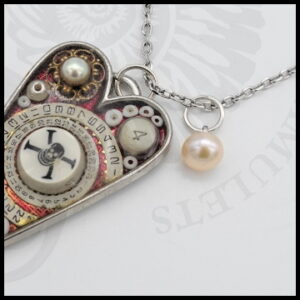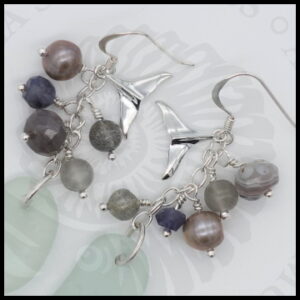The month of June actually has three birthstones.
These are pearl, moonstone and Alexandrite.

I’ll be focusing on pearls here as they’re the most commonly acknowledged as the June birthstone. There’s also a link to moonstone jewellery at the end of the article.
There is a confusing array of pearls available but they can be broken down into three different kinds. Any pearl available today will have been created by one of these three processes.
- Natural pearls.
- Cultured pearls.
- Synthetic pearls.
1. Natural pearls are extremely rare and very expensive.
This puts them out of the reach of most buyers. Natural pearls occur when an irritant finds its own way inside a living oyster shell or mollusc. The creature within, as a natural defence against the uninvited aggravation, then covers it in layers of nacre. This forms the pearl and can take years to develop in this way.
2. Cultured pearls are formed in the same way.
The difference is that the introduction of the irritant (nucleus) is deliberate and calculated. This is usually embedded by a pearl farmer, on a pearl farm, which mimics natural conditions. Cultured pearls can be saltwater or freshwater and have slightly different qualities. Pale shades of cream, grey and lavender are likely to be natural. Dark pearls are likely to have been artificially dyed with the exception of the Tahitian “peacock” coloured pearl.
3. Synthetic pearls are man-made.
As you’d expect this makes them cheap and cheerful. They’re usually made from glass, plastic, alabaster or shells and have a pearly coating making them look pretty similar to real pearls. They are a really fun way to wear pearls if your budget doesn’t run to something more expensive. An easy way to tell if a pearl is real or man-made is to feel it between your teeth. Natural or cultured pearls are slightly gritty whereas fake pearls are smooth. If you love June’s birthstone but don’t want, or can’t afford, real pearls, synthetic is the way to go!
 As a vegetarian, I have considered whether pearl farming can be considered cruelty free or not. This is open to debate. The insertion of an irritant and the harvesting of the created pearl are not natural processes. The shellfish’s reaction which creates the pearl over a number of months or years is entirely natural and is unlikely to cause the creature any distress. Shellfish do not have such sensitive nervous systems as other creatures so careful pearl farmers are not hurting the very animals that provide their living.
As a vegetarian, I have considered whether pearl farming can be considered cruelty free or not. This is open to debate. The insertion of an irritant and the harvesting of the created pearl are not natural processes. The shellfish’s reaction which creates the pearl over a number of months or years is entirely natural and is unlikely to cause the creature any distress. Shellfish do not have such sensitive nervous systems as other creatures so careful pearl farmers are not hurting the very animals that provide their living.
The molluscs can be used again to create another pearl, by its natural reaction to an irritant, and they are generally kept in conditions that replicate their natural environment ensuring the farmers get the best product at the end of the process. So, whilst pearls can’t be considered “vegan” because they are an animal product it’s fair to say they can be considered “cruelty free” and suitable for vegetarians. I don’t buy new pearls as their provenance is hard to establish. The pearls I have in my collection, which I use for my jewellery, are either second-hand, from estate sales and some have been gifted.
Pearls are known as the “stone of sincerity.”
June’s birthstone pearl represents purity, innocence and loyalty. They are said to focus the wearer’s attention, inhibit boisterous behaviour and enhance personal integrity. Pearls are frequently given as a token of love or affection as well as good luck. They are a symbol of wisdom and are valued for their calming effects. Pearls also represent perfection, wealth and good fortune.
Jewellery and any other items with pearls can be viewed HERE. Jewellery and any other items with moonstones can be viewed HERE.